The northern gannet has the same colours as the Australasian gannet and is similar in appearance. Nesting in colonies as large as 60,000 pairs on both sides of the north Atlantic this bird undertakes seasonal migrations and is a spectacular high-speed diver.
Old names for the northern gannet include solan and solan goose.

Description
Northern gannet breeding pairs
Northern gannet flying over the English Channel, in the 7 Islands Nature Reserve, northern France
The plumage of the adults is white with dark wing tips, with colours that range from brown to black. The colour of the head, cheeks and side of the neck depends on the season and the individual; during breeding, the head and neck are brushed in a delicate yellow, although this colouring may not be evident in some individuals.[6] The feathers are waterproof, which allows the birds to spend long periods in water. A water-impermeable secretion produced by a sebaceous gland covers the feathers and the birds spread it across their body using their beak or their head.[7] The eye is light blue, and it is surrounded by bare, black skin, which gives the birds their characteristic facial expression.
Young northern gannet. The front part of its body shows adult plumage.
Young birds are dark brown
Newborn chicks are featherless and are dark blue or black in colour. In the second week of life they are covered in white down.[10] From the fifth week they are covered in dark brown feathers flecked with white.[6]
Their beak is long, strong and conical with a slight downward curve at the end. The front part has a sharp edge. In adults, the beak is blue-grey with dark grey or black edges. It is brownish in immature birds.
The northern gannet’s eyes are large and point forwards, and they have a light blue to light grey iris surrounded by a thin black ring. The four toes of their feet are joined by a membrane that can vary from dark grey to dark brown. There are yellow lines running along the toes that continue along their legs; these lines probably have a role in mating.[7] The rear toe is strong and faces inwards allowing the birds to firmly grip onto vertical cliff faces.[11]
Distinguishing anatomical features
Northern gannet on Bonaventure Island, in Quebec
Selecting a dive target
Plunge-diving with wings retracted
The lungs are highly developed and probably also play a role in reducing the effects of hitting water at high speeds and protecting the body from these effects. There are subcutaneous air sacs in the lower body and along the sides. Other air sacs are located between the sternum and the pectoral muscles and between the ribs and the intercostal muscles. These sacs are connected to the lungs and are filled with air when the bird breathes in. The air can be expelled by muscle contractions.[12]
Individuals have a subcutaneous fat layer, dense down and tightly overlapping feathers that help them withstand low temperatures. A reduced blood flow in the webbing on their feet outside of the breeding season also helps to maintain body temperature when they swim.[13]
By air, land and sea
Silhouette in flight
They alight on water with their feet retracted. They rarely land on water with their feet stretched forward like pelicans or cormorants. When they are on the water their body is rather low in the water with their tail pointing diagonally upwards. They alight with difficulty on land and often with a bump as their narrow wings do not allow them to turn easily and they have to use their feet and tail to aid in these manoeuvres. Individuals often suffer damage to their legs or feet when they land on the ground if there is not sufficient wind.[16] Damaged or broken wings are a frequent cause of death in adults.[17] The position of the legs towards the rear of the body means that they walk in a similar way to ducks.
Northern gannet colony on Bonaventure Island near to Percé, Quebec, Canada
Call
Northern Gannet calls from Grassholm. Wales.
According to the ornithologist Bryan Nelson northern gannets can recognize the call of their breeding partner, chicks and birds in neighbouring nests. Individuals from outside this sphere are treated with more aggression.[20]
Distribution
Breeding colonies in the north Atlantic
Panoramic view of the Seven Island Nature Reserve that supports a northern gannet colony, in Brittany (France)
The northern limit of their breeding area depends on the presence of waters that are free of sea ice during the breeding season. Therefore, while Greenland and Spitsbergen offer suitable breeding sites, the arctic regions have summers that are too short to allow the northern gannets to lay their eggs and raise a brood, which requires between 26 and 30 weeks.[24] The southern limit of their distribution mainly depends on the presence of sufficient prey.[25]
The species is a rare visitor in the Black Sea region.[26]
Breeding colonies
- Bass Rock off the east coast of Scotland, first recorded in 1448.[28] In 2004, it contained more than 48 000 nests.[29] This is where part of the species’ Latin name comes from. The Bass Rock is now the world's largest colony of Northern gannets. Visitors to the Scottish Seabird Centre have the opportunity to see the Bass Rock via interactive live cameras in the Centre and on seasonal boat trips.
- Saint Kilda and Sula Sgeir, in the Hebrides. Saint Kilda is the largest colony in Europe with more than 60 000 nests.[29]
- Sceilg Bheag one of the Skellig Islands located off the South West Coast is the largest colony in Ireland hosting around 30,000 pairs.
- Eldey off Iceland, where between 14 000 and 15 000 pairs breed.[30][31]
Population
A 2004 survey counted 45 breeding colonies and some 361 000 nests.[32] The population is apparently growing between 3% and 5% a year, although this growth is concentrated in just a few colonies.[32] Although northern gannet populations are now stable, their numbers were once greatly reduced due to loss of habitat, removal of eggs and killing of adults for their meat and feathers. In 1939, there were 22 colonies and some 83 000 nests, which means that the populations have increased fourfold since that time.[24] This increase in numbers could also be due to northern gannets benefiting from the growing activities of deep sea fishing.In 1992, the International Union for the Conservation of Nature (IUCN) estimated the bird’s population to be some 526 000.[33] However, taking into account an estimate produced for BirdLife International in 2004 of the European population, the IUCN revised its global population to between 950 000 and 1 200 000 individuals.[34]
A count was undertaken on the Bass Rock population in 2014 - this was an aerial count and confirmed the Bass Rock as the world's largest colony with over 150,000 pairs.
Conservation status
Nests among the rocks. The population of this species appears to be increasing.
In the United Kingdom, gannets are a protected species. However, a legal exception is made for the inhabitants of the district of Ness (also known as Nis) of the Isle of Lewis in Scotland's Outer Hebrides, who are allowed to cull up to 2,000 gannets (locally known as guga) annually to serve as a traditional local delicacy—the taste is described as fishy.[35] Many of these gannets are taken from Sula Sgeir, which is itself named after them.
Depredation
This species is not heavily predated. The only known habitual natural predators of adults are the bald and white-tailed eagles.[36]Predators of eggs and nestlings include the great black-backed gull and American herring gull, common ravens, ermine, and red fox. Predation at sea is insignificant though large sharks and seals may rarely snatch a gannet out at sea.[36]
Diet and foraging
Northern gannets forage for food during the day, generally by diving into the sea. They search for food both near to their nesting sites but also further out to sea. Birds that are feeding young have been recorded searching for food up to 320 km (200 mi) from their nest. It has been found that 2% of birds nesting in the colony on Bass Rock search for fish at Dogger Bank, between 280 and 320 km (170 and 200 mi) away. It is likely that they fly greater distances than this while searching for food, possibly up to double this distance; however, they normally fly less than 150 km (93 mi).[37]Diving
When feeding, these birds are spectacular high-speed divers. They can locate their prey from heights of up to 45 m (148 ft), but they normally search from a height of between 10 and 20 m (33 and 66 ft).[38] When they see a fish they will dive into the water. They dive with their bodies straight and rigid, wings tucked close to the body but reaching back, extending beyond the tail, before piercing the water like an arrow. They control the direction of the dive using their wings.[39] Just as it is going to hit the water a bird will fold its wings against its body. A bird’s head and neck are stretched out in front of the body and the beak is shut.[39] Birds can hit the water at speeds of up to 100 km/h (62 mph). This allows them to penetrate 3–5 m (10–16 ft) below the surface, and occasionally they will swim down to 12–15 m (40–50 ft).
Northern gannet searching for fish
Their white colour helps other gannets to identify one of their kind and they can deduce the presence of a shoal of fish by this diving behaviour; this in turn facilitates group foraging, which makes capturing their prey easier.[40] Northern gannets also forage for fish while swimming with their head under water.
Some studies have found that the duration and direction of flights made while foraging for food are similar for both sexes. However, there are significant differences in the search behaviour of males and females. Female northern gannets are not only more selective than males in choosing a search area: they also make longer and deeper dives and spend more time floating on the surface than males.[41]
Diet
They eat mainly fish 2.5–30.5 cm (0.98–12.01 in) in length which shoal near the surface. Virtually any small fish (roughly 80–90% of their diet) or other small pelagic species (largely squid) will be taken opportunistically. Sardines, anchovies, haddock, smelt, Atlantic cod and other shoal-forming species are eaten.[42][43] In the case of the larger fish species northern gannets will only eat the young fish.They will also follow fishing boats with the hope of finding food in the same way as gulls do. They fly around the boats to take fish from the fishing nets or pick up the remains thrown into the sea.[44]
Reproduction
The oldest birds are the first to return to the breeding colonies. The exact duration of the breeding season depends on the colony’s geographic location: the breeding season on Bass Rock starts in the middle of January, that of Iceland at the end of March or in April.[45] The birds that are not of breeding age arrive a few weeks later. In general, birds first return to a colony (not necessarily the one they were born in) when they are two or three years old.[46] It is not unusual for birds to change colony before they reach breeding age, but once an individual has successfully bred in a colony it will not change to another.[47]Immature birds stay on the edges of the colony. They may even make a nest but they will not breed until they are four or five years old.[45] Some birds of this age will occupy empty nests that they will aggressively defend if they have sat on them for two or three days. If an apparently empty nest has an owner the immature bird will abandon it without putting up a struggle when the owner arrives to claim the nest.[48]
Nest construction
Northern gannet transporting material for its nest.\
Nests are made from seaweed, plants, earth and all types of object that float on the sea. The males usually collect the materials. Nests measure between 50 and 70 cm (20 and 28 in) in diameter and are some 30 cm (12 in) in height; during the course of a breeding season they will sustain damage from the wind and other causes and they require frequent maintenance. The area which a nest occupies grows throughout the breeding season as the breeding pairs throw their excrement outside the nest.
Aggressive behaviour on the nest
Female will not react if a male approaches her nest, but she will defend it fiercely if another female approaches
Mating
"Billing", a mutual greeting gesture[53]
Mating
Gannet pairs are monogamous and may remain together over several seasons, if not for all their lives. The pairs separate when their chicks leave the nest but they pair up again the following year. Should one of the pair die the other bird will leave the breeding ground and pair up with another single bird.
They fiercely defend the area around their nest. Where space allows, the distance between nests is double the reach of an individual.
Eggs and chicks
Northern gannets only lay one egg that on average weighs 104.5 grams.[54] This is lighter than for other seabirds.[55] Where two eggs are found in a nest this is the result of two females laying an egg in the same nest or one of the eggs has been stolen from another nest. Northern gannets will lay another egg if the first one is lost. Incubation takes 42 to 46 days. During incubation the egg is surrounded by the brooding bird’s webbed feet that are flooded with warming blood. The process of breaking the eggshell can take up to 36 hours. When this is about to take place the brooding bird will release the egg from its webbed feet to prevent the egg from breaking under the adult's weight as the chick breaks it open. This is a frequent cause of death for chicks of birds that are breeding for the first time.[56] The webbed feet are also used to cover the chicks, which are only rarely left alone by their parents. Chicks that are left unattended are often attacked and killed by other northern gannets.[57]Young chicks are fed regurgitated semi-digested fish by their parents. Older chicks receive whole fish. Unlike the chicks of other species, northern gannet chicks do not move about the nest or flap their wings to ask for food: this reduces the likelihood that they will fall from the nest.[58]
The adults feed their offspring for 11 or 12 weeks, until they are strong enough to leave the nest for good. A chick will glide from the nest down to the sea after 75 days, which will mark the point at which it separates permanently from its parents.[46] Young birds that weigh 4 kg (8.8 lb) at this point will not be able to fly so they are unable to return to the cliff. Their fat reserves allow them to pass two or three weeks without eating. If the young birds leave the nest in bad weather they can be mortally wounded as they can be blown against the rocks.[57]
The young birds are attacked by adults if they enter the breeding ground, so they stay at sea learning to fish and fly. A high proportion of the young birds can die if storms occur at this time.[59]
Migration
The young birds migrate southwards for great distances and have even been recorded as far south as Ecuador. In their second year a number of birds return to the colony they were born in, where they arrive after the mature birds, they will then migrate south again at the end of the breeding season. They travel shorter distances in this second migration.After the breeding season the adults spread out over a wide area although they travel no more than 800 to 1,600 km (500 to 990 mi) from the breeding colony. It is not known if all birds from one colony migrate to the same over-wintering area. Many adults migrate to the west of the Mediterranean, passing over the Strait of Gibraltar and flying over land as little as possible. Other birds follow Africa's Atlantic coastline to arrive in the Gulf of Guinea. Immature northern gannets from colonies in Canada fly to the Gulf of Mexico while the adults do not fly that far.[37]
Gallery
-
Seabird skulls. In decreasing size: gannet, yellow-legged gull, skua , common murre, razorbill and Atlantic puffin.
-
Northern gannets usually nest close together on cliff ledges
-
"Sky pointing", gesture made to signal that a bird is about to fly away from the nest[53]
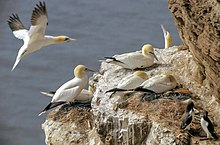
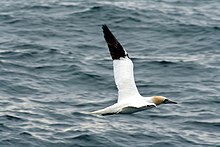
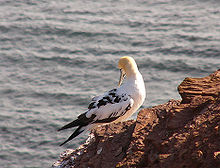

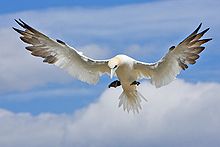
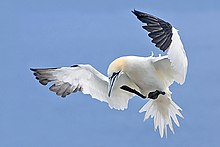

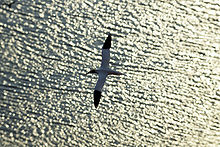





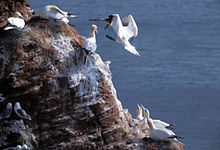


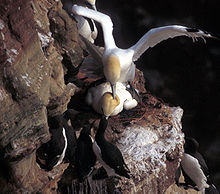






No comments:
Post a Comment
Note: Only a member of this blog may post a comment.